Chapter 1: Reproduction in Lower and Higher Plants
Multiple choice question.
Insect pollinated flowers usually posses ______
Sticky pollens with rough surface
Large quantities of pollens
Dry pollens with smooth surface
Light coloured pollens
In ovule, meiosis occurs in ______
integument
nucellus
megaspore
megaspore mother cell
The ploidy level is not the same in ______.
Integuments and nucellus
Root tip and shoot tip
Secondary nucleus and endosperm
Antipodals and synergids
Which of the following types require pollinator but the result is genetically similar to autogamy?
Geitonogamy
Xenogamy
Apogamy
Cleistogamy
If diploid chromosome number in a flowering plant is 12, then which one of the following will have 6 chromosomes?
Endosperm
Leaf cells
Cotyledons
Synergids
In angiosperms, endosperm is formed by/ due to ______
free nuclear divisions of megaspore
polar nuclei
polar nuclei and male gamete
synergids and male gamete
Point out the odd one.
Nucellus
Embryo sac
Micropyle
Pollen grain
Very short answer type question:
Name the part of gynoecium that determines the compatible nature of pollen grain.
Solution:
Pistil determines the compatible nature of pollen grain.
How many haploid cells are present in a mature embryo sac?
Solution:
Total 6 haploid cells are present in a mature embryo sac. They are antipodal cells (3), synergids (2), and egg cell (1).
Even though each pollen grain has 2 male gametes, why at least 20 pollen grains are required to fertilize 20 ovules in a particular carpel?
Solution:
During double fertilisation, one of the male gamete of pollen grain fuses with egg cell, while other male gamete fuses with secondary nucleus. Thus to fertilize 20 ovules in a particular carpel, 20 pollen grains are required.
Define megasporogenesis.
Solution:
It is the process of formation of haploid megaspores from diploid megaspore mother cell (MMC) by meiotic division.
What is hydrophily?
Solution:
Pollination carried out by water is called hydrophily.
Name the layer which supplies nourishment to the developing pollen grains.
Solution:
Tapetum supplies nourishment to the developing pollen grains.
Define Parthenocarpy.
Solution:
It is the condition in which fruit is developed without the process of fertilization is called parthenocarpy.
Are pollination and fertilization necessary in apomixis?
Solution:
In apomixis, the embryo is formed without the formation of gametes and fertilization.
Thus, pollination and fertilization are not necessary for apomixis.
Name the parts of pistil which develop into fruits and seeds.
Solution:
After fertilization, the ovary of the pistil develops into fruit and ovules into seeds.
What is the function of filiform apparatus?
Solution:
Filiform apparatus guide the entry of pollen tube towards the egg.
Short Answer Question:
How polyembryony can be commercially exploited?
Solution:
1. Polyembryony increases the chances of survival of the new plants.
2. Genetically uniform parental type seedlings are obtained from nucellar embryos, thus nucellar adventive polyembryony is of great significance in horticulture.
3. Plantlets obtained from these embryos are disease-free.
4. These embryos can be isolated and grown on embryo culture to produce clones.
Pollination and seeds formation is very crucial for fruit formation. Justify the statement.
Solution:
1. Pollination is a very important part of the life cycle of a flowering plant.
2. The flowers must be pollinated in order to bring about the process of fertilization.
3. Pollination brings male and female gametes of a flower together during fertilization.
4. As a result of fertilization, ovary develops into fruits and ovules into seeds.
5. Seeds on germination give rise to a new plant that further grows and develops fruits and seeds. Thus pollination and seed formation are required to create offsprings for the next generation.
Incompatibility is a natural barrier in the fusion of gametes. How will you explain this statement?
Solution:
1. Incompatibility refers to inability of certain gametes even from genetically similar plant species to fuse with each other.
2. It is considered as the most prevalent and effective device to avoid inbreeding and outbreeding.
3. Pollen pistil interaction is a dynamic process that involves pollen recognition followed by promotion or inhibition of the pollen.
4. Chemical substances released by the style act as a barrier.
5. Typically the pollen belonging to the correct mating type germinates on stigma, develops a pollen tube, and brings about fertilization.
6. The pollens belonging to the other mating type are discarded.
Thus, incompatibility is a natural barrier in the fusion of gametes.
Describe three devices by which cross-pollination is encouraged in angiosperms by avoiding self- pollination.
Solution:
Genetic diversity is an essential factor for evolution by natural selection. Continued self-pollination results in inbreeding depression. Thus, plants have developed many devices to encourage cross-pollination. Examples of outbreeding devices are as follows:
Unisexuality:
In this, the plant bears either male or female flowers. It is also called as dioecism.
As flowers are unisexual, self-pollination is not possible. Plants may be monoecious,
e.g. Maize or dioecious, e.g. Mulberry, Papaya.
Dichogamy:
In this, anthers and stigmas mature at different times in a bisexual flower due to which self-pollination is prevented. It can be further divided into two types:
a. Protandry:
In this type, anthers mature first, but the stigma of the same flower is not receptive at that time.
e.g. in the disc florets of sunflower.
b. Protogyny:
In this type, stigma of carpel matures earlier than anthers of the same flower. e.g. Gloriosa.
Prepotency:
In this, pollen grains of other flowers germinate rapidly over the stigma than the pollen grains from the same flower, e.g. Apple.
Heterostyly (heteromorphy):
Plants like Primula (Primrose) produce two or three types of flowers in which stigmas and anthers are placed at different levels (heterostyly and heteroanthy).
This prevents the pollens from reaching the stigma and pollinating it. In heteromorphic flowers, pollen grains produced from anther pollinate stigmas produced at the same level.
Thus self-pollination is not possible in such cases.
Herkogamy:
It is a mechanical device to prevent self-pollination in a bisexual flower. In plants, a natural physical barrier is present between two sex organs and avoid contact of pollen with the stigma of the same flower, in e.g. Calotropis, pentangular stigma is positioned above the level of anthers (pollinia).
Self-incompatibility (self-sterility):
This is a genetic mechanism due to which the germination of pollen on the stigma of the same flower is inhibited, e.g. Tobacco, Thea.
Long Answer Question:
Describe the process of double fertilization.
Solution:
Double fertilization:
1. The fusion of one male gamete with an egg and that of another male gamete with a secondary nucleus is called as double fertilization.
It is the characteristic feature of angiosperms.
It was discovered by Nawaschin in the liliaceous plants like Lilium and Fritillaria.
2. When pollen grain reaches the surface of the stigma, it germinates and forms a pollen tube.
3. Pollen tube penetrates the stigma, style, ovary chamber and then enters the ovule.
4. The growth of the pollen tube is guided by the chemicals secreted by the synergids.
5. Usually, when a pollen tube enters the ovule through the micropyle, it is termed as porogamy.
But in some cases, it enters through chalaza which is known as chalazogamy. In some plants, it enters by piercing the integuments which are called mesogamy.
6. A pollen tube penetrates the embryo sac of ovule through its micropylar end.
7. The pollen tube carrying male gametes penetrates in one of the synergids.
8. Watery contents of synergid are absorbed by the pollen tube, due to which it ruptures and releases the contents, including the two non-motile male gametes.
9. As non-motile male gametes are carried through a hollow pollen tube, it is known as siphonogamy that ensures fertilization to take place.
10. Fertilization mainly involves two processes: Syngamy and Triple fusion.
a. Syngamy:
It is the fusion of haploid male gamete with a haploid female gamete (egg). It results in the formation of a diploid zygote which develops to form an embryo. Syngamy is a type of generative fertilization.
b. Triple fusion:
It is the fusion of second haploid male gamete with diploid secondary nucleus. It results in the formation of Primary Endosperm Nucleus (PEN) which develops into triploid endosperm. Triple fusion is a type of vegetative fertilization.
11. In this process, both the male gametes participate, due to which fertilization occurs twice in the same embryo sac, hence it is described as double fertilization.
Explain the stages involved in the maturation of microspore into a male gametophyte.
Solution:
Development of male gametophyte
1. Pollen grain/microspore marks the beginning of male gametophyte, thus it is the first cell of the male gametophyte.
2. It undergoes the first mitotic division to produce bigger, naked vegetative cells and small, thin-walled generative cells.
3. The vegetative cell is rich in food and having an irregularly shaped nucleus.
4. The generative cell floats in the cytoplasm of the vegetative cells.
5. The second mitotic division is concerned with generative cells only and gives rise to two non-motile male gametes.
6. The mitotic division of the generative cells takes place either in the pollen grain or in the pollen tube.
7. The pollen grains are shed from the anther, at this two-celled stage in most of the angiosperms.
Explain the development of dicot embryos.
Solution:
A: Oospore.
B: Two celled proembryo.
e: embryonal initial;
t: suspensor initial;
m: Embryo sac membrane.
B1 : 4-celled I-shaped proembryo;
e1, e2: embryonal initial; s1, s2 : suspensor initial.
C: Further development of embryo.
S: Suspensor, h: Hypophysis; E: Embryonal mass
D: L. S. of ovule
Endo: Endosperm in free nuclear stage.
Anti: Antipodal tissue.
Embryo: Developing embryo
E: Embryo showing further development of embryonic octants and hypophysis.
F: L. S. of ovule. Endosperm becoming cellular.
G: Embryo; Cot: Cotyledons; Hypo: Hypocotyl; Rad: Radicle; R.c.: Rootcap;
H: Mature seed; Pl: Plumule. Endosperm has been consumed almost completely
Development of dicot embryo:
1. The zygote divides to form two-celled proembryo.
2. The larger cell towards the micropyle is called basal or suspensor initial cell and smaller cell towards chalaza is called terminal or embryonal initial cell.
3. The suspensor cell divides transversely in one plane to produce filamentous suspensor of 6-10 cells.
4. The first cell of the suspensor towards the micropylar end becomes swollen and functions as a haustorium.
5. The lowermost cell of the suspensor is known as hypophysis.
6. The suspensor helps in pushing the embryo in the endosperm.
7. The embryonal initial undergoes three successive mitotic divisions to form octant.
8.The planes of divisions are at right angles to each other.
9. The lower tier of four cells of octant gives rise to hypocotyl and radicle whereas four cells of the upper-tier form the plumule and the one or two cotyledons.
10. The hypophysis by further division gives rise to the part of radicle and root cap.
11. Subsequently, the cells in the upper tier of the octant divide into several planes so as to become heart-shaped which then forms two lateral cotyledons and a terminal plumule.
12. Further enlargement of hypocotyl and cotyledons result in a curvature of the embryo and it appears horseshoe-shaped.
Draw a labeled diagram of the L.S. of anatropous ovule and list the components of the embryo sac and mention their fate after fertilization.
1. Structure of anatropous ovule:
2. List the components of embryo sac and mention their fate after fertilization:
Fill in the blank:
The _________ collect the pollen grains.
Solution:
The stigma collect the pollen grains.
The male whorl, called the ________ produces ________.
Solution:
The male whorl, called the androecium produces pollen grains.
The pollen grains represent the ________.
Solution:
The pollen grains represent the male gametophyte.
The ________contains the egg or ovum.
Solution:
The embryo sac contains the egg or ovum.
________takes place when one male gamete and the egg fuse together. The fertilized egg grows into a seed from which the new plants can grow.
Solution:
Syngamy (fertilization) takes place when one male gamete and the egg fuse together. The fertilized egg grows into a seed from which the new plants can grow.
The ______ is the base of the flower to which other floral parts are attached.
Solution:
The thalamus is the base of the flower to which other floral parts are attached.
________is the transfer of pollen grains from the anther of the flower to the stigma of the same or a different flower
Solution:
Pollination is the transfer of pollen grains from the anther of the flower to the stigma of the same or a different flower.
Once the pollen reaches the stigma, the pollen tube traverses down the ________to the ovary where fertilization occurs.
Solution:
Once the pollen reaches the stigma, the pollen tube traverses down the style to the ovary where fertilization occurs.
The ______ are coloured to attract the insects that carry the pollen. Some flowers also produce ______ or ______ that attracts insects.
Solution:
The petals are coloured to attract the insects that carry the pollen. Some flowers also produce sweet odour or nectar that attracts insects.
The whorl ________is green that protects the flower until it opens.
Solution:
The whorl calyx is green that protects the flower until it opens.
Label the parts of seed.
Solution:
Match the column.
A - V, B - I, C - II, D - IV
A - III, B - IV, C - I, D - V
A - IV, B - I, C - V, D - II
A - IV, B - V, C - III, D - II
Solution:
A - IV, B - I, C - V, D - II
Biology 12th Standard
Balbharati Solutions for Biology 12th Standard HSC Maharashtra State Board Chapterwise List - Free
Chapter 1: Reproduction in Lower and Higher Plants
Chapter 2: Reproduction in Lower and Higher Animals
Chapter 3: Inheritance and Variation
Chapter 4: Molecular Basis of Inheritance
Chapter 5: Origin and Evolution of Life
Chapter 6: Plant Water Relation
Chapter 7: Plant Growth and Mineral Nutrition
Chapter 8: Respiration and Circulation
Chapter 9: Control and Coordination
Chapter 10: Human Health and Diseases
Chapter 11: Enhancement of Food Production
Chapter 13: Organisms and Populations
Chapter 14: Ecosystems and Energy Flow
Chapter 15: Biodiversity, Conservation and Environmental Issues
Board Paper With Solutions
MARCH 2013, OCTOBER 2013, MARCH 2014, OCTOBER 2014, MARCH 2015, JULY 2015, MARCH 2016, JULY 2016. MARCH 2017, JULY 2017




